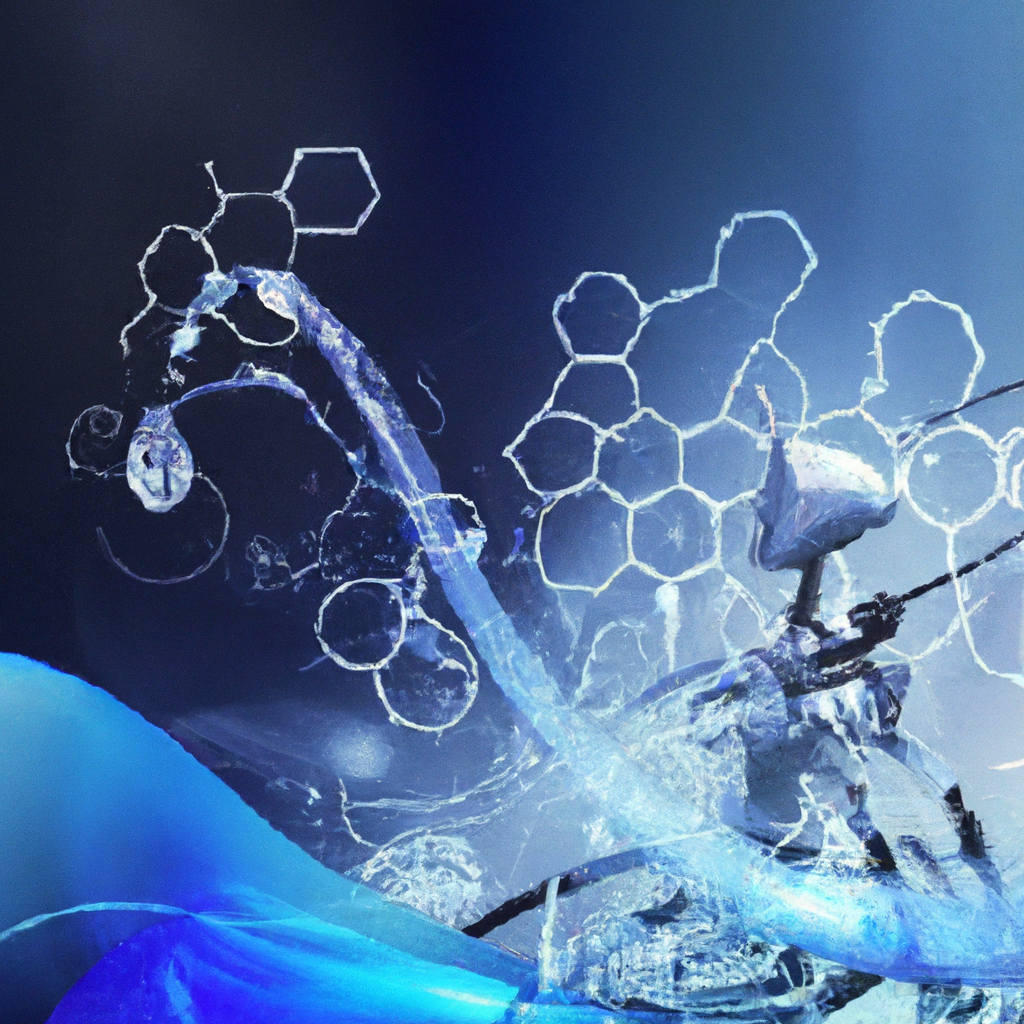Imagine a world where biology, nanotechnology, and digital technology merge effortlessly, leading to groundbreaking advancements in various industries. This is the essence of the Fourth Industrial Revolution, where the convergence of bio, nano, and digital tech opens endless possibilities for innovation and transformation. In this article, we will explore the exciting developments unfolding in this revolution and how they are reshaping the future of technology and society. So strap in and get ready to embark on a journey into the world of the Fourth Industrial Revolution.
Understanding the Fourth Industrial Revolution
The concept and the driving forces
The Fourth Industrial Revolution refers to the current era of rapid technological advancements and the integration of digital, biological, and nanotechnology. It is characterized by the fusion of different disciplines, resulting in revolutionary changes in various aspects of society, economy, and daily life. The driving forces behind this revolution include advancements in communication technology, artificial intelligence, robotics, and the Internet of Things (IoT). These developments are leading to new possibilities and opportunities for innovation, as well as profound disruptions in various industries.
Comparison with the previous industrial revolutions
The Fourth Industrial Revolution differs from the previous three industrial revolutions in terms of scope, scale, and impact. The first industrial revolution marked the transition from agrarian to industrialized societies through mechanization and steam power. The second industrial revolution introduced mass production through the use of electricity and division of labor. The third industrial revolution brought about automation and digitalization. In contrast, the Fourth Industrial Revolution is characterized by the convergence of technologies and the blurring of physical, digital, and biological boundaries. It has the potential to fundamentally alter the way we live, work, and interact.
Role of technology and innovation
Technology and innovation are at the heart of the Fourth Industrial Revolution. Breakthroughs in digital, biological, and nano technologies are driving the transformation of various industries and enabling new ways of doing things. For example, the Internet of Things is connecting devices and enabling the collection of vast amounts of data, which can be used to improve efficiency and create new business models. Artificial intelligence and machine learning are revolutionizing areas such as healthcare, finance, and transportation. The rapid pace of technological advancements necessitates a culture of innovation and adaptability, as well as investments in research and development.
Bio-Technology in the Fourth Industrial Revolution
Development and application of bio-technology
Bio-technology, which is the use of living organisms or their products for technological advancements, plays a crucial role in the Fourth Industrial Revolution. It encompasses various fields such as genetics, genomics, synthetic biology, and regenerative medicine. The development of bio-technology has led to significant breakthroughs, including the decoding of the human genome, the production of genetically modified organisms, and the ability to manipulate cells for medical purposes. These advancements are opening up new opportunities in healthcare, agriculture, energy, and environmental sustainability.
Impact on healthcare and medical science
Bio-technology has the potential to revolutionize healthcare by enabling personalized medicine, improving diagnostics, and advancing treatments. With the decoding of the human genome, it is now possible to identify genetic predispositions to diseases and develop targeted therapies. gene editing technologies like CRISPR-Cas9 offer the potential to cure genetic disorders and eradicate certain diseases. Additionally, bio-technology is facilitating advancements in regenerative medicine, such as tissue engineering and organ transplantation. These developments have the potential to improve patient outcomes, prolong life expectancy, and enhance quality of life.
Genomics and synthetic biology
Genomics, the branch of bio-technology that focuses on the study of genomes, is a key area of research in the Fourth Industrial Revolution. The ability to sequence and analyze DNA has opened up new possibilities for understanding the genetic basis of diseases and developing personalized treatments. Genomic data can be used to identify biomarkers, predict disease risks, and optimize drug therapies. Synthetic biology, on the other hand, involves the design and construction of new biological parts, devices, and systems. It allows for the engineering of organisms with novel functions and the production of bio-based materials and fuels. These advancements in genomics and synthetic biology are transforming multiple industries, including healthcare, agriculture, and bio-manufacturing.

Nano-Technology in the Fourth Industrial Revolution
Advancements in nano-technology
Nano-technology, the science and engineering of materials and devices at the nanometer scale, is another critical component of the Fourth Industrial Revolution. It involves manipulating and controlling matter at the atomic and molecular levels to create new materials and structures with unique properties. Advances in nano-technology have resulted in the development of nanomaterials, nano-electronics, and nano-devices. These advancements have the potential to revolutionize various industries, including electronics, energy, manufacturing, and healthcare. Nano-technology enables miniaturization, increased efficiency, and enhanced functionality in many applications.
Nano-technology in electronics and materials science
In the realm of electronics, nano-technology has led to the development of smaller, faster, and more efficient devices. Nanoscale components and materials can be used to create high-performance transistors, memory chips, and displays. Nano-electronics also enables the integration of sensors, actuators, and communication capabilities into everyday objects, giving rise to the Internet of Things. Furthermore, nano-technology has revolutionized materials science by allowing for the creation of materials with enhanced properties such as increased strength, flexibility, and conductivity. These materials have applications in areas such as aerospace, automotive, and construction.
Industrial applications of nano-technology
Nano-technology is finding diverse applications across various industries. In manufacturing, nano-technology enables the development of advanced materials and coatings with improved durability, corrosion resistance, and self-cleaning properties. It also facilitates the production of nanostructured materials with tailored properties for specific applications. In the energy sector, nano-technology is being used to enhance solar cells, improve energy storage systems, and develop more efficient catalysts for fuel cells. Additionally, nano-technology has applications in healthcare, including targeted drug delivery systems, diagnostic tools, and bio-sensors. These industrial applications of nano-technology have the potential to improve efficiency, reduce costs, and create new business opportunities.
Digital Technology in the Fourth Industrial Revolution
Evolution of digital technology
Digital technology, which encompasses areas such as computing, communication, data analytics, and the Internet, is a fundamental driver of the Fourth Industrial Revolution. Over the years, digital technology has evolved at a rapid pace, resulting in innovations such as personal computers, smartphones, cloud computing, and big data analytics. These advancements have transformed the way we live, work, and interact, enabling instant communication, access to information, and global connectivity. The evolution of digital technology has laid the foundation for the integration of bio and nano technologies, creating new possibilities and challenges.
Implications for communication and information technology
The Fourth Industrial Revolution has profound implications for communication and information technology. The increasing connectivity, made possible by digital technology, has enabled the sharing of data, information, and knowledge on a global scale. This has led to the democratization of information, as well as the emergence of new communication platforms and social networks. Additionally, digital technology has revolutionized fields such as e-commerce, online banking, and digital entertainment. It has transformed the way we conduct business, access services, and entertain ourselves. However, these advancements also raise concerns about privacy, security, and the digital divide.
Artificial intelligence and machine learning
Artificial intelligence (AI) and machine learning are among the most significant developments in the realm of digital technology. AI refers to the simulation of human intelligence in machines, enabling them to perform tasks that normally require human intelligence, such as visual perception, speech recognition, and decision-making. Machine learning, on the other hand, involves the development of algorithms that allow machines to learn from data and improve their performance over time. These technologies have far-reaching implications in various domains, including healthcare, finance, transportation, and manufacturing. They enable automation, predictive analytics, and personalized experiences, revolutionizing the way we work and interact with machines.

Convergence of Bio, Nano, and Digital Tech
Understanding the concept of technological convergence
Technological convergence refers to the integration and interaction of different technologies to create new opportunities and innovations. The Fourth Industrial Revolution is characterized by the convergence of bio, nano, and digital technologies, resulting in synergies and transformative advancements. The combination of these technologies enables new possibilities and applications that were previously unimaginable. For example, the integration of bio and nano technologies enables the development of personalized medicine and targeted drug delivery systems. The integration of digital and bio technologies facilitates the collection and analysis of health data for personalized healthcare. Convergence opens up new frontiers of innovation and brings about radical changes in various industries.
Synergy between bio, nano, and digital technologies
The synergy between bio, nano, and digital technologies lies in their complementary capabilities and potential for collaboration. Bio-technology provides the understanding of living systems and enables the manipulation of biological processes. Nano-technology allows for precise control of matter at the nanoscale and the creation of novel materials and structures. Digital technology provides the computational power, connectivity, and data processing capabilities required to harness the potential of bio and nano technologies. The integration of these technologies results in enhanced functionalities, improved efficiency, and new opportunities for innovation. For example, the combination of bio and nano technologies enables the development of wearable devices for health monitoring, while digital technology facilitates the analysis and interpretation of the data collected.
Cases of successful convergence
There are numerous examples of successful convergence between bio, nano, and digital technologies. One such example is the field of personalized medicine, where genomics, nano-sensors, and data analytics are combined to develop tailored treatments for individuals. Another example is the development of bio-sensors that can detect diseases at an early stage by analyzing biological samples through nano-sized devices connected to digital platforms for real-time monitoring. Furthermore, the convergence of these technologies has led to advancements in precision agriculture, smart cities, renewable energy, and environmental monitoring. These cases demonstrate the transformative potential of convergence and the possibilities it opens up for innovation and progress.
Impact of the Fourth Industrial Revolution on Economy
Changes in the employment landscape
The Fourth Industrial Revolution is expected to bring significant changes to the employment landscape. While it will create new job opportunities in emerging industries, it will also disrupt traditional sectors and lead to job displacement. Automation and artificial intelligence are expected to replace certain tasks and roles, especially those that are routine and repetitive. However, the revolution will also create demand for new skills and expertise in areas such as data analytics, AI programming, cybersecurity, and bio-engineering. The challenge lies in ensuring a smooth transition for workers and equipping them with the necessary skills to thrive in the new digital economy.
Effect on global trade and economic growth
The Fourth Industrial Revolution has the potential to reshape global trade and economic growth patterns. The integration of bio, nano, and digital technologies enables the creation of new products, services, and business models, which can lead to increased productivity and innovation. It also enables companies to leverage global connectivity and digital platforms to access new markets and customers. However, the revolution also raises concerns about the concentration of wealth and power in the hands of a few dominant players, as well as the impact on labor markets and inequality. The challenge lies in ensuring inclusive growth and equitable distribution of the benefits of the revolution.
Emergence of new industries and transformation of existing ones
The Fourth Industrial Revolution is giving rise to new industries and transforming existing ones. Emerging industries such as biotechnology, nanotechnology, renewable energy, and digital services are expected to play a significant role in the future economy. These industries offer new opportunities for innovation, job creation, and economic growth. Traditional industries, on the other hand, are being disrupted by digital technologies and automation. For example, the retail sector is experiencing a shift towards e-commerce, while the manufacturing sector is adopting advanced robotics and additive manufacturing. The transformation of industries requires adaptation, re-skilling, and investment in research and development to stay competitive in the new digital landscape.

Effect on Society and Lifestyle
Changes in the way we work, communicate, and interact
The Fourth Industrial Revolution is transforming the way we work, communicate, and interact with each other. Flexible work arrangements and remote work options are becoming more prevalent, enabled by digital technologies and connectivity. The revolution is also changing the nature of work, with automation and AI taking over routine and repetitive tasks, while humans focus on more complex and creative work. Communication and collaboration are being facilitated by digital platforms, making it easier to connect with people globally and share information. Furthermore, the revolution is blurring the boundaries between the physical and digital worlds, resulting in new ways of interacting and experiencing the world, such as virtual reality and augmented reality.
Impact on privacy and security
The Fourth Industrial Revolution presents new challenges and concerns regarding privacy and security. The increasing connectivity and collection of data raise questions about the ownership, control, and use of personal information. There are concerns about data breaches, identity theft, and surveillance in the digital age. The revolution also raises ethical considerations regarding the use of technology in areas such as AI, biometrics, and genetic manipulation. Balancing the benefits of technology with privacy and security requires robust regulations, cybersecurity measures, and ethical frameworks. It also necessitates a greater awareness and understanding of digital rights and responsibilities among individuals and organizations.
Influence on education and learning
The Fourth Industrial Revolution is reshaping education and learning. The rapid pace of technological advancements requires individuals to continuously update their skills and acquire new knowledge. Lifelong learning and adaptability are becoming essential in order to thrive in the digital age. The revolution also presents new opportunities for personalized and interactive learning through online platforms, virtual classrooms, and AI-driven tutoring systems. Furthermore, the integration of bio, nano, and digital technologies is leading to the emergence of new interdisciplinary fields and the need for cross-cutting skills. Education systems and institutions need to adapt to these changes and equip individuals with the skills and knowledge required for the digital economy.
Ethical and Regulatory Considerations
Ethical challenges posed by new technologies
The Fourth Industrial Revolution raises ethical challenges that need to be addressed. The development and application of technologies such as AI, genetic engineering, and surveillance systems raise questions about the limits and consequences of human intervention in nature and society. There are concerns about privacy, autonomy, and consent in the context of data collection and analysis. Additionally, there are ethical considerations regarding the use of AI and automation in decision-making processes, such as hiring, criminal justice, and healthcare. It is important to have ethical frameworks and guidelines in place to ensure that technological advancements are aligned with human values and serve the common good.
Need for regulation and oversight
The Fourth Industrial Revolution necessitates regulation and oversight to ensure the responsible and ethical development and use of technologies. The rapid pace of technological advancements often outpaces the development of regulatory frameworks, creating a gap that can be exploited or result in unintended consequences. It is important to establish regulations that address issues such as data privacy, cybersecurity, environmental protection, and technological biases. Regulatory frameworks should strike a balance between innovation and risk mitigation, supporting the development and deployment of new technologies while safeguarding public interest and well-being. Additionally, oversight mechanisms are needed to monitor and enforce compliance with regulations and ethical standards.
Role of policy makers and international cooperation
The Fourth Industrial Revolution requires policy makers to take a proactive role in shaping the direction and impact of technological advancements. Policy decisions regarding research funding, intellectual property rights, education and workforce training, and international collaboration can have significant implications for the future of the revolution. It is important for policy makers to engage with stakeholders from academia, industry, and civil society to understand the potential risks and benefits of technologies and to promote responsible innovation. International cooperation and coordination are crucial to address global challenges and ensure that the benefits of the revolution are equitably distributed.

Risks and Challenges
Technological disruption and inequality
The Fourth Industrial Revolution carries risks and challenges, including technological disruption and inequality. Automation and AI have the potential to displace jobs and create a divide between those with the necessary skills and those without. This can exacerbate existing inequalities and lead to social and economic polarization. It is important to ensure that the benefits of technological advancements are accessible to all and that measures are in place to support those who are adversely affected by the revolution. This includes investments in education and re-skilling programs, social safety nets, and inclusive policies that promote equal opportunities and economic mobility.
Sustainability and environmental concerns
The Fourth Industrial Revolution presents both opportunities and challenges in the context of sustainability and environmental concerns. While technological advancements can contribute to sustainable development and address global challenges such as climate change, they can also have negative environmental impacts. The production, use, and disposal of digital devices, as well as the energy consumption of data centers, contribute to carbon emissions and resource depletion. Furthermore, the use of bio and nano technologies raises concerns about potential environmental risks and unintended consequences. It is essential to adopt a holistic and sustainable approach to technological development, considering the environmental impact throughout the lifecycle of technologies and promoting eco-friendly practices.
Security risks associated with digital technology
The Fourth Industrial Revolution introduces new security risks and vulnerabilities associated with digital technology. The increasing connectivity and dependence on digital systems make them potential targets for cyber-attacks, data breaches, and other security threats. The revolution also creates challenges in terms of data privacy, protection of personal information, and prevention of unauthorized access. It is crucial to invest in cybersecurity measures, including encryption, authentication, and monitoring systems, to ensure the integrity and security of digital infrastructure. Additionally, individuals and organizations need to be aware of and adhere to best practices for cybersecurity, such as regular software updates, strong passwords, and employee training.
The Future of the Fourth Industrial Revolution
Potential for further technological breakthroughs
The Fourth Industrial Revolution holds immense potential for further technological breakthroughs. The convergence of bio, nano, and digital technologies creates new possibilities for innovation, discovery, and problem-solving. As the revolution progresses, we can expect advancements in areas such as personalized medicine, renewable energy, sustainable agriculture, and smart cities. Breakthroughs in AI, robotics, and automation will continue to transform industries and create new opportunities. It is important to foster a culture of innovation, invest in research and development, and provide support for entrepreneurial ventures to propel the revolution forward and unlock its full potential.
Preparations for the future – education and workforce training
In order to navigate and harness the opportunities of the Fourth Industrial Revolution, preparations for the future must be made in terms of education and workforce training. The revolution is changing the skills required in the job market, with increasing demand for digital literacy, computational thinking, problem-solving, and adaptability. Education systems need to evolve to equip individuals with the necessary skills and knowledge to thrive in the digital economy. This includes integrating digital literacy into curricula, promoting interdisciplinary learning, and emphasizing lifelong learning. Workforce training programs and initiatives should also be in place to reskill and upskill individuals to meet the demands of emerging industries and occupations.
The role of government and private sector in steering the revolution
The Fourth Industrial Revolution requires collaboration and cooperation between governments, the private sector, and civil society to steer its trajectory and ensure its positive impact. Governments play a vital role in setting policies, regulations, and frameworks that support innovation, protect public interest, and address societal challenges. The private sector, on the other hand, drives innovation, invests in research and development, and brings technological advancements to market. Collaboration between governments and the private sector is essential to address global challenges, promote responsible innovation, and shape the direction of the revolution. Civil society also has a role to play in advocating for ethical and sustainable practices and ensuring that the revolution benefits all members of society.
In conclusion, the Fourth Industrial Revolution is a transformative era characterized by the convergence of bio, nano, and digital technologies. It has the potential to revolutionize various industries, improve healthcare, enhance productivity, and transform society. However, it also presents challenges and risks that need to be addressed, including job displacement, inequality, ethical considerations, and security risks. Navigating the revolution requires proactive efforts from all stakeholders, including policy makers, researchers, educators, and individuals. By embracing the potential of technological advancements, fostering innovation, and prioritizing inclusiveness and sustainability, we can steer the revolution towards a future that benefits humanity as a whole.











